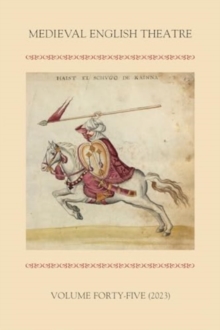
Medieval English Theatre 44 PDF
Edited by Meg Twycross, Sarah Carpenter, Elisabeth Dutton, Gordon L Kipling
Part of the Medieval English Theatre series
Description
Newest research into drama and performance of the Middle Ages and Tudor period.
Medieval English Theatre is the premier journal in early theatre studies. Its name belies its wide range of interest: it publishes articles on theatre and pageantry from across the British Isles up to the opening of the London playhouses and the suppression of the civic religious plays , and also includes contributions on European and Latin drama, together with analyses of modern survivals or equivalents, and of research productions of medieval plays.
The papers in this volume explore richly interlocking topics. Themes of royalty and play continue from Volume 43. We have the first in-depth examination of the employment of the now-famous Black Tudor trumpeter, John Blanke, at the royal courts of Henry VII and Henry VIII. An entertaining survey of the popular European game of blanket-tossing accompanies the translation of a raucous, sophisticated, but surprisingly humane Dutch rederijkers farce. The Towneley plays remain fertile ground for further research, and this blanket-tossing farce illuminates a key scene of the well-known Second Shepherd's Play. New exploration of a colloquial reference to 'Stafford Blue' in another Towneley pageant, Noah, not only enlivens the play's social context but contributes to important current re-thinking of the manuscript's date. Two papers bring home the theatrical potential of food and eating. We learn how the Tudor interlude Jacob and Esau dramatises the preparation and provision of food from the Genesis story. Serving and eating meals becomes a means of social, theological, and theatrical manipulation. Contrastingly, in the N. Town Last Supper play and a French convent drama, we see how the bread of Passover, the Last Supper, and the Mass could be evoked, layered and shared in performance. In both these plays the audiences' experiences of theatre and of communion overlap and inform each other.
Information
-
Download - Immediately Available
- Format:PDF
- Pages:172 pages
- Publisher:Boydell & Brewer Ltd
- Publication Date:13/06/2023
- Category:
- ISBN:9781805430438
Information
-
Download - Immediately Available
- Format:PDF
- Pages:172 pages
- Publisher:Boydell & Brewer Ltd
- Publication Date:13/06/2023
- Category:
- ISBN:9781805430438










